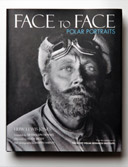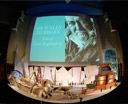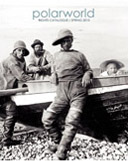 Our ProductsOur Resources |
This website requires the free Flash plugin to be installed.
Polarworld - discover more polar booksThe Arctic Book ReviewApostle to the Inuit: The Journals and Ethnographic Edited by Frédéric Laugrand, Jarich Oosten and François Trudel Reviewed by Kenn Harper For too long the Reverend Edmund James Peck has been an enigmatic figure in Arctic mission history and in the history of Baffin Island. Known as the “Apostle to the Inuit” and as the man who brought formal Christianity to the Inuit of Arctic Quebec and then to the Baffin Region, yet the details of his life and work and his contribution to our knowledge of the historical Inuit remained undocumented. The only book-length biography, “The Life and Work of E. J. Peck among the Eskimos,” by Arthur Lewis, was published over a century ago, before his work at Blacklead Island had ended, and, like many missionary biographies, was heavy on the hallelujahs and light on substance. Now three respected academics known for their studies of Inuit history and beliefs have collaborated on a work of almost 500 pages dealing exclusively with Peck’s Baffin years, the four two-year terms he spent at Blacklead Island (interspersed with one-year furloughs to England) between 1894 and 1905. The facts of Peck’s career can be recounted easily enough. He was born in England in 1850 but raised from the age of seven in Ireland. Orphaned at thirteen, he spent eight years in the British Navy before answering a plea that Rev. John Horden, Bishop of Moosonee, had made to the Church Missionary Society for a man who could devote his time almost exclusively to the Inuit on the Quebec Hudson Bay coast. Between 1876 and 1892, Peck served two terms as missionary at Little Whale River and Fort George, continuing the work begun but interrupted in the 1850s by Rev. E. A. Watkins. In 1894, leaving his wife and daughter behind in England, Peck established a new mission to the Inuit at the whaling station of Blacklead Island in Cumberland Sound, the main centre of commercial activity north of Hudson Strait. After leaving Blacklead Island in 1905 Peck moved with his family to Ottawa where he became Superintendent of Arctic Missions, travelling north occasionally on supply vessels in the summer. He died in Ottawa in 1924. The authors begin their work with a lengthy introduction describing the founding of the mission on Blacklead Island and the work of introducing Christianity to the Inuit. This background, augmented by a very helpful chronology of the significant events in the eleven years under study, puts in context the main body of the work which follows in two major sections. Over 200 pages are devoted to Peck’s journals of his eleven-year residence in Cumberland Sound. These are presented primarily as extracts, with very little commentary. This works – the extracts speak for themselves. But it is “Part Two: The Ethnographic Documents,” which is the more interesting. Missionaries are not usually ethnographers. Most view their task as to eradicate, rather than document, the “heathen” beliefs of pre-Christian times. Peck might very well have fallen into this camp too, had it not been for the invitation of the pioneer anthropologist, Franz Boas, to document for him the belief system of the Inuit, collect legends and write up shamanic rituals. Certainly there is nothing in Peck’s earlier writings of his time on the Hudson Bay coast, or even in his notes from his first few years at Blacklead Island, that indicated any interest in these subjects. But Boas’s invitation struck a chord in Peck. Already unconventional in many of his attitudes to how missionary activity should be conducted, Peck took up Boas’s challenge. His contribution to the ethnography of the Inuit has sat largely untouched and unrecognized for over a century in the General Synod Archives of the Anglican Church of Canada. It is a remarkable collection of information that the authors present here. An introductory chapter, “The Ethnography of Peck,” is followed by four chapters of Peck’s own documentation of Inuit customs. Chapter titles give the flavour of the work: “The Eskimos, Their Beliefs, Characteristics, and Needs,” “Describing ‘Heathen Customs’,” “The Tuurngait” [helping spirits], and “List of Spirits by the Missionary E. J. Peck.” Of especial interest are three chapters of stories recorded verbatim from Inuit themselves, Eve Nooeyout, Oosotapik and Qoojessie. The authors might have provided more background on the history of Blacklead Island prior to Peck’s arrival. Discovered – and I mean in the classical sense in which the first white man to enter an area inhabited by non-whites is heralded as a discoverer - by John Davis in 1585 and not re-discovered until 1840 by William Penny with the help of the Inuk, Eenoolooapik, parts of Cumberland Sound had been continuously occupied by whalers for almost half a century before Peck’s arrival. Indeed whaling was in serious decline well before 1894. Unlike Boas, whose year in Cumberland Sound (1882-3) resulted in a major documentation of Inuit life and beliefs in which the white presence in the area is virtually unmentioned, giving the reader an inaccurate picture of Inuit living a traditional life unsullied by foreign influences, Peck does not gloss over the presence of the whalers and the vices and diseases they had brought to the people he had come to save. A few quibbles with fact and interpretation: William Penny reached Cumberland Sound in 1840, not 1839 (page 12). Mr. Noble (Crawford Noble) was not the agent who occupied the whaling station at Kikkerton in the 1880s; rather, he was the owner, resident in Scotland, who employed the agents resident on the island (page 14). A picture caption on page 25 purports to identify the first three Inuit converts on Blacklead Island, but, if conversion is marked by baptism, it is in error; the first Inuk to be baptised on the island was Annie Atungaujaq, who died in June 1901, little more than a month after her baptism on May 7 of that year. The spellings of Inuit names and Inuktitut place-names in the text generally follow Peck’s own renditions. But in the authors’ own descriptive text, where names that are not used by Peck are introduced, the authors generally attempt to use the modern official Inuit orthography. In this they are deficient. In particular, Peck’s own Inuktitut name was Uqammak (the one who speaks well), not Uqammaq (page 10 and elsewhere). [A small “mea culpa” is required here. In citing my short unpublished biography of Peck that is on file at the General Synod Archives, they accurately quote my own early mis-spelling of Peck’s Inuktitut name as “Uqarmat.” That shouldn’t, however, give them the right to mis-spell my first name as “Ken” on page 3!] Joseph Parker was called Luuktakuluk (the small doctor), not Luktaakuluk (page 16), and Greenshield was Ilataaqauk (the new member of the family), not Ilataaqqau (page 16). Blacklead Island itself, on the map that accompanies the introduction, should be Uummannarjuaq, not Uumanarjuaq. But these are small points in a major work. The authors have accomplished very well their objective of placing Edmund James Peck firmly among the roster of those who have made major contributions to documenting the pre-Christian beliefs of the Inuit. The Apostle to the Inuit takes his place as an ethnographer who performed the unusual task – one might call it an almost schizophrenic task - of eliciting and documenting the very belief system he was so firmly dedicated to extinguishing. |
|
||
follow us  | join us | join us  | home | contact | home | contact
|
||||
|
© Copyright Polarworld Ltd
SiteWizard.co.uk Web Site Design Company |
||||


